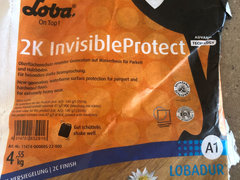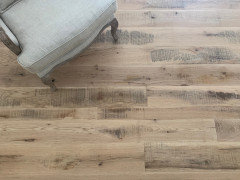Questions about Loba Invisible & Supra
cac546
6 years ago
Featured Answer
Sort by:Oldest
Comments (184)
HU-231824251
3 years agoG & S Floor Service
3 years agoRelated Discussions
Loba invisible or rubio monocoat
Comments (9)Both Loba and Rubio are "special" finishes. Special in that not everyone is A. aware of them or B. trained on them. Loba Invisible is a water based finish with a low-gloss finish (it is their "matte" finish in the AT line). It is for those people who want the LOOK of oil finished without the MAINTENANCE of oil finished. The cost of Loba (any of their options) will be the up-front material costs. They are expensive but thankfully you get MORE than you pay for. More benefits. More scratch resistance. Excellent longevity. As a water based finish, it has different working times (wet edges are very different time frame than oil based finishes). And the mixing can be confusing for a refinisher "trying it out" for the first time. Other than the learning curve and the costs, it is relatively easy to use...ONCE the refinisher understands the process. In fact many people praise how easy it is...AFTER they get used to it! The Rubio is different. It is a relatively low-cost product to PURCHASE...but the costs come in the LABOUR. Rubio requires PERFECTION when it comes to sanding. It can take an extra 2-3 passes with the sander (and much higher grit levels) than a traditional/water based polyurethane. So...your refinisher absolutely MUST be trained on the sanding technique. If not, it will look ABYSMAL! And I mean crying and a sense of hopelessness - "How did this happen?" or "What do I do now?" are the questions often asked once a Rubio floor is mucked up. So Rubio has extra costs hidden in the LABOUR costs...but the material costs are quite low. And then there is the maintenance. Loba = none. Just basic wipe with damp cloths, sweep, refinish in 20 years. Rubio = much more. The homeowner will need to have ALL the cleaning and repair products ON HAND for the very first day of possession. The homeowner should pay the contractor to give a "maintenance" lesson before the hand over of the keys to the house. This should include scrubbing technique, cleaning techniques and then application techniques with both cleaning oils, maintenance oils AND the coloured oil (if you stain) should it be required to do a full patch at some time. The Hardwax oils are lovely. But they require certain maintenance. And in a lively household that can be spot cleaning and reapplying the finish if a stain appears. Water spots will need to be dealt with by a spot cleaning and reapplication of the colour/finish. Adding in the yearly "whole home" maintenance oiling" is another requirement. This can be done in high traffic areas every year...and then every 2-3 years you can move all the furniture out of the way and apply the maintenance oil over the entire space. You then leave for 6-8 hours and when you come back it should be ready for the furniture to be put back. Happily this can be done room by room as your home allows...which means it can take a week or more to do all the floors in all the rooms if you go one-by-one. You are welcome to hire these jobs out...but the beauty of the Rubio is it is supposed to be easy enough for the homeowner to maintain. But that means the homeowner has to take the time and the effort (out of his/her busy schedule) to do all the maintenance. Loba...simply love it and leave it. I'm far too lazy to deal with hardwax oils. Regardless of how I feel about the LOOK of them, I know darned well that I'm too lazy to take on 20+ years of homeowner maintenance. Homeowner, Know Thyself....See MoreLoba Supra 2K & AT combo
Comments (92)@druszky Are you certain without doubt that first layer was not some type of primer? Loba does produce a waterborne primer called WS EasyPrime that is designed to receive a topcoat layer within about 45 minutes to 2 hours of primer application. If the first layer was EasyPrime, then 30 minutes later Invisible Protect AT, then you would be OK. It's distressing to me that so many people are after the extreme matte look in coatings. First, it leads to situations like you have here where clearer coats were used first, then a matte coat used last. This retains the clarity of the coating overall but makes repairs more difficult. Also, I am not a coatings expert but have generally noticed with the amount of reading I have done this year on coatings that a higher gloss finish tends to wear better in some cases in terms of not prematurely failing. I don't know if that is because of properties that allow a greater surface resilience or what. Then, you also have the situation @SJ McCarthy mentioned, where wear along a matte topcoat can produce shiny sections. Most people selecting coatings for their homes are probably not informed by the contractors in advance about these types of issues, or perhaps more people would opt for a higher sheen....See MoreLoba 2k Invisible - Application Question
Comments (17)Hey Laurasreed47, I'm actually getting our floors slightly refinished. We've had them now for about a year and while they look great, they are slightly prone to absorption of liquids. So, out of an abundance of caution, I figured I'd call in a Loba specialist to have them looked at. Sure enough, he said that this was the result of the floors not having been sanded between the final coats. Thankfully we don't need to have them completely redone - they're just lightly sanding our current finish and then applying a final top coat. He said this should do the trick and that this finish is 'one of the best and most durable on the market' so I feel good about it. As I mentioned in the original post, I did everything within my power to try and guide the floor guy our contractor used to the proper application method but was ignored. I think it's been mentioned in a thread somewhere else, but I should have just trusted my gut and found a Loba specialist to begin with. I'm glad we don't have to completely refinish the floors in the end, but it's still a frustration. Also, 'stopping all work' and 'sitting down with contractors to make them make amends' isn't always a viable option. Renovating a co-op apartment in NYC is generally an exercise in constantly making peace with disappointments. Oh, and lastly - the photos I included above aren't really accurate of the final look of the floors. We were still deep in the construction phase (of course I would have liked to have the floors done as the final item but our NYC renovation has been a real nightmare so I took what I could get) so it doesn't really reflect their final look. The floor LOOKS fantastic (I don't know what SJ Mcarthy was referring to with seeing the 'cardboard indentations', to be honest). We did stop work and allow it to cure to a full week when it was first applied but, as mentioned, three coats on top of one another just wasn't enough - the intermediary sanding is crucial. So that's it. Sorry for the long response but wanted to make sure you had all the info. Hope it helps....See MoreBona Traffic HD extra matte, Loba 2k invisible protect or Loba Supra?
Comments (9)The industries do like to say keep your products in one li. However, there are people who mix them with success. Lobadoes make a red outproduct. That is probably, if not exactly the same, very similar to the red out;It is simply some sort of chemical combination of Peroxides and lye. The biggest problem you have with using red out or any version of it from an company is that you have to sand before using any of the Poly's and you might sand off the bleaching, but obviously people do this and end up with pretty floors. And thank you for the compliments on my floor.Thedifficulty with Bona is it has a very fast, dry time. The Lobo is easier to work with period. The difficulty with invisible is that you really need to pay attention to lap marks. But there are great videos out there. The invisible Has a very dry look...See MoreAglitter
3 years agolast modified: 3 years agoSJ McCarthy
3 years agoHU-231824251
3 years agolast modified: 3 years agoSJ McCarthy
3 years agoHU-231824251
3 years agoSJ McCarthy
3 years agoAglitter
3 years agolast modified: 3 years agoHU-231824251
3 years agoAglitter
3 years agolast modified: 3 years agoG & S Floor Service
3 years agolast modified: 3 years agoSJ McCarthy
3 years agonataliapaul
3 years agoSJ McCarthy
3 years agoAglitter
3 years agolast modified: 3 years agoHU-231824251
3 years agolast modified: 3 years agoAglitter
3 years agolast modified: 3 years agostacy7464
2 years agoherbert lash
2 years agoG & S Floor Service
2 years agostacysylvestri
2 years agoAglitter
2 years agolast modified: 2 years agoLiz Patterson
last yearSteven Harder
last yearMr. Baker
last yearG & S Floor Service
last yearAglitter
last yearMr. Baker
last yearAglitter
last yearlast modified: last yearMr. Baker
last yearAglitter
last yearG & S Floor Service
last yearMr. Baker
last yearMr. Baker
last yearAglitter
last yearlast modified: last yearMr. Baker
last yearMr. Baker
last yearAglitter
last yearMr. Baker
last yearG & S Floor Service
last yearAglitter
last yearBrittany Ferrieri
last monthAglitter
last monthlast modified: last monthAglitter
last monthBrittany Ferrieri
last monthG & S Floor Service
last monthBrittany Ferrieri
last monthG & S Floor Service
last monthAglitter
last monthlast modified: last month
Sponsored
Columbus Area's Luxury Design Build Firm | 17x Best of Houzz Winner!












SJ McCarthy